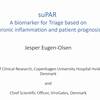Interview with first author Viktor Curovic on his work on suPAR in diabetes patients
suPARnostic See all
interview on the following publication:
Diabetes Care. 2019 Jun;42(6):1112-1119. doi: 10.2337/dc18-1427. Epub 2019 Mar 18.
Soluble Urokinase Plasminogen Activator Receptor Predicts Cardiovascular Events, Kidney Function Decline, and Mortality in Patients With Type 1 Diabetes.
Rotbain Curovic V1, Theilade S2, Winther SA2, Tofte N2, Eugen-Olsen J3, Persson F2, Hansen TW2, Jeppesen J4,5, Rossing P2,5.
Author information
Abstract
OBJECTIVE:
RESEARCH DESIGN AND METHODS:
RESULTS:
CONCLUSIONS:
Soluble urokinase plasminogen activator receptor (suPAR) is an important inflammatory biomarker implicated in endothelial and podocyte dysfunction. However, suPAR's predictive qualities for complications in type 1 diabetes have yet to be determined. We investigated the prognostic value of suPAR for the development of cardiovascular events, decline in renal function, and mortality in patients with type 1 diabetes.
We included 667 patients with type 1 diabetes with various degrees of albuminuria in a prospective study. End points were cardiovascular events (cardiovascular death, nonfatal acute myocardial infarction, nonfatal stroke, or coronary or peripheral arterial interventions), estimated glomerular filtration rate (eGFR) decline ≥30%, progression from lower to higher albuminuric state, development of end-stage renal disease (ESRD), and mortality. Follow-up was 5.2-6.2 years. Results were adjusted for known risk factors. Hazard ratios (HRs) are presented per doubling of suPAR with 95% CI. Relative integrated discrimination improvement (rIDI) was calculated.
Quantification of suPAR was available in all participants; median (interquartile range) was 3.4 ng/mL (2.7-4.5). The adjusted HR (95% CI) for cardiovascular events (n = 94), progression in albuminuria (n = 36), eGFR decline (n = 93), ESRD (n = 23), and mortality (n = 58) were 3.13 (1.96-5.45, P < 0.001), 1.27 (0.51-3.19, P = 0.61), 2.93 (1.68-5.11, P < 0.001), 2.82 (0.73-11.9, P = 0.13), and 4.13 (1.96-8.69, P < 0.001), respectively. rIDI was significant for cardiovascular events (22.6%, P < 0.001), eGFR decline (14.4%, P < 0.001), and mortality (23.9%, P < 0.001).
In patients with type 1 diabetes and a broad range of albuminuria, a higher level of suPAR is a significant and independent risk factor for cardiovascular events, decline in eGFR ≥30%, and mortality. In addition, suPAR contributes significantly to discrimination for the end points.
suPARnostic See all
Dr Eugen-Olsen talks on chronic inflammation and how it is linked to the...
|
|||||










































































































